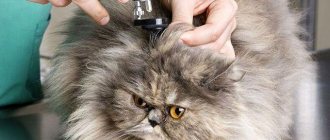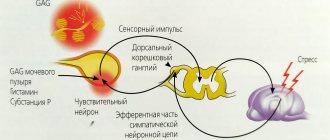Reasons for development
Puppies are most susceptible to this disease, that is, dogs up to a year old or a little older, and they suffer it most severely. Infection occurs by airborne droplets, and the “carrier” of the disease can be dogs that once (on average three to six months ago) suffered from bordetellosis.
When a healthy dog comes into contact with an infectious dog, infection can easily occur. This cold can await you at any time of the year. In winter - due to decreased immunity due to cold and dampness, and in summer due to longer walks and more frequent contact with other animals.
Any reasons for decreased immunity can increase the risk of infection:
- stress;
- hypothermia;
- drafts.
This disease can also manifest itself during a dog’s pregnancy. If the dog became infected two or three years ago, then the disease might not have started at that time, but began during a time of severe stress for the body - pregnancy, when a complete restructuring of all processes in the body occurs.
Causes
According to statistics, animals most often become infected with bordetellosis at various dog shows or kennels, that is, in places where there is a large concentration of them. When transporting animals, the chances of infection increase, since all kinds of contact with dogs or cats that have not been quarantined lead to infection.
The main factors contributing to the development of the disease include:
- hypothermia of the body;
- negative impact of drafts;
- severe stress.
Dog hypothermia is one of the causes of bordetellosis
Note! Dogs most often encounter the disease in wet weather or extreme cold, but bordetellosis does not have any affiliation with one season or another. Therefore, the disease can be diagnosed at any time of the year.
Symptoms of bordetellosis
Bordetelosis or Bordetella bronchiseptica in dogs is also called “kennel cough.”
The disease can be in acute and chronic forms. The first signs of the disease may appear after only twenty days, so you are unlikely to remember exactly where and from whom you “caught” such an unpleasant “gift”.
Acute form
Incorrect or delayed treatment of bordetellosis can lead to the development of such a serious disease as bronchitis, which can ultimately develop into pneumonia. Therefore, it is important not to miss the onset of a mild illness in order to prevent death from a seemingly simple disease.
Main symptoms:
- decreased appetite;
- lethargy, the dog does not get up unless absolutely necessary;
- sneezing and mucus from the nose;
- increase in body temperature to 40-41 degrees;
- severe cough that gets worse while moving;
- weakness of the body;
- the animal refuses to play and tries to lie down more.
Read Causes of pug ear allergies: treatment methods and diet
If you understand a little about canine anatomy, you can easily feel enlarged (even huge and swollen) lymph nodes.
If you see such symptoms in your dog, you should immediately contact a veterinary clinic, because making a correct diagnosis in this case is very important, and only professional veterinarians can do this. Even if it turns out that you only needlessly bothered your four-legged friend with a trip to the clinic, then in this case it is better, as they say, to be safe than sorry.
Chronic form
If the disease becomes chronic, the dog may develop symptoms of rhinitis (inflammation of the nasal mucosa) and conjunctivitis (inflammation and suppuration of the eyes). All this is accompanied by discharge from the eyes and nose. There is also a cough (but much less than in the acute form), sneezing, sometimes fever, loss of appetite, and enlarged submandibular lymph nodes. Also, the dog will still have an elevated body temperature, will still be less active and will only get up when absolutely necessary.
Dogs and other pets that have had bordetellosis for 4-5 months become dangerous to other healthy animals. The fact is that the causative agent of this disease begins to be released into the environment, which contributes to the infection of other animals.
Principles of disease treatment
When treating bordetellosis, it is first important to establish the sensitivity of the bacterium to a specific antibiotic. This is the main condition for successful treatment of a bacterial infection. Therefore, it is not recommended to give medications to the owner on their own; you can treat the dog in vain by feeding it with antibiotics, which have no effect on Bordetella.
If it was not possible to determine sensitivity in the laboratory, then the choice falls on the group of tetracyclines (doxycycline). Bordetella is neutral to penicillins and trimethoprim.
In addition to specific therapy aimed at destroying the causative agent of the disease, the dog must be given symptomatic treatment that will support the body and restore electrolyte and acid-base balance (droppers). Be sure to mechanically clean the mouth and nasal passages of mucus, crusts, and deposits in the corners of the eyes. Transfer to a clean, dry and warm room.
If your dog shows signs of malaise, has nasal discharge, conjunctivitis, coughing, or has previously had contact with unfamiliar animals or been in a kennel - do not hesitate! Call the RosVet VC by phone: +7 (495) 256-11-11, 24 hours a day. Make an appointment with your veterinarian and have your pet examined. Experts remind that it is easier to treat a dog at the very beginning of the development of bordetellosis than to deal with a severe course of the disease or a complication.
Diagnostics
At the first symptoms of the disease, you should immediately contact your veterinarian for help. A thorough diagnostic examination is necessary, since the course of bordetellosis can easily be confused with the course of other, less serious diseases. To make an accurate diagnosis, various diagnostic measures are used, including a veterinary laboratory.
- First, the veterinarian simply examines the dog, studies all the symptoms known to him, interviews the owner and simply observes the dog’s behavior. Checks lymph nodes.
- The veterinarian uses polymerase chain reaction. This is a very effective diagnostic method for kennel cough, as it can detect even small amounts of infectious molecules.
- Doctors often use a bacteriological method to determine the disease. With this method, the veterinarian uses a sterile swab and inoculates it on a nutrient medium.
- Serological diagnostics are used, during which specific antibodies and their interactions with other antibodies are studied. This method is one hundred percent accurate for determining the disease.
It is worth remembering that bordetellosis is often accompanied by other equally serious pathologies. This must be remembered in order to correctly set the course of treatment.
Symptoms
The disease occurs in the following forms:
- Spicy.
- Permanent.
Dogs in the kennel
Acute form
Most often, kittens and puppies are affected during the first 12 weeks of life. The disease is characterized by the following symptoms:
- poor appetite;
- sneeze;
- cough that gets worse when standing up and moving around;
- sputum separation;
- oppression, the baby is constantly lying down;
- temperature rise - 40–41 °C;
- exhaustion.
With improper treatment, bronchitis develops, turning into pneumonia, which often ends in the death of the animal.
Chronic form
It is characterized by the same signs as acute, only they do not appear so clearly. Additional symptoms appear:
- conjunctivitis with copious discharge;
- rhinitis accompanied by nasal discharge;
- lymphadenitis with hypertrophy of local lymph nodes in the submandibular space.
Treatment options
If treatment was provided in a timely manner, all symptoms of the disease will gradually begin to disappear and will disappear completely in one and a half to two weeks, but the duration of bacterial carriage (carriage of infectious agents) can remain from 3 to 4 months. During treatment, the sick animal is separated from the rest (this stage is very important so that the sick animal does not infect healthy dogs and especially puppies), the most comfortable conditions are created, and general restorative, symptomatic and antimicrobial treatment is carried out. Each of these methods differs in the nature of the therapeutic strategy.
Read Causes of alopecia in Spitz: effective ways to eliminate the problem
General restorative therapy
The doctor prescribes immunostimulating medications aimed at strengthening the body's protective functions. Everything is like people. The most effective general strengthening drugs include drugs such as Gamavit and Ribotan. They can be easily found at any pet pharmacy. Also, during treatment, you should try to provide the dog with good nutrition; it is better to choose expensive canned food.
Eliminating symptoms
After an accurate confirmation of the diagnosis by a veterinarian, the animals are regularly examined and their eyes and nose are cleaned of dried exudate. The use of expectorants (like all other drugs) should be under the strict supervision of a specialist. All drugs that the doctor prescribes are potent, so using them alone or in the wrong dose can lead to side effects and aggravate the disease. To prevent this from happening, you must strictly follow your veterinarian's instructions.
To treat kennel cough in dogs’ ears and eyes, antiseptic drugs such as “Bars”, “Iris” and “Diamond Eyes” are used. They can be easily obtained at a regular pet store; there is no need to look for a pet pharmacy. Also very effective are drugs such as Nazivin and Dioxidin, which you can easily buy at a regular pharmacy or even find in your personal first aid kit, because people suffer from a runny nose quite often.
Antimicrobial
Most often, a drug such as Doxycycline is prescribed for this disease. This drug is used as a last resort when the action of semi-synthetic antibiotics does not give the desired result. But here only a veterinarian can really help you, because choosing such serious drugs on your own can lead to dire consequences.
Causes
Young animals get sick. Clinically healthy animals can be bacteria carriers. Most often, mixed infections occur, which are collectively called kennel cough based on the main symptom. Animals kept individually get sick very rarely. An important condition for the development of infection is its intensification during passage through many organisms. No pronounced seasonality of bordetellosis outbreaks is observed. The cause of infection may be:
- importation of new individuals without quarantine;
- Exhibitions;
- crowded content;
- stress;
- hypothermia.
The latent period lasts 5–20 days. Signs of the disease in cats are the same as in dogs.
Cats in the nursery
Prevention
Most of the causes of the disease are natural conditions beyond human control (for example, dampness or contact with another dog). When bordetellosis occurs, great attention must be paid to compliance with animal hygiene requirements and other preventive measures so that the episode of the disease does not recur either with this dog or with any other dog that will be in contact with the same premises.
After treatment, you should try not to walk your dog in the cold or in the rain for too long; in the summer, reduce communication with other animals to a minimum and allow it only if you know the dog’s owner well and are sure that his animal has not had kennel cough in the last six months or is not sick Now.
Dogs are also vaccinated against this unpleasant disease. Vaccination is carried out at a veterinary clinic, where they will select the correct vaccine and give an injection. And you can protect your pet from primary or even secondary infection.
Read Causes of hematobartonellosis in dogs: signs and methods of treatment
Prevention of bordetellosis in cats
Since various environmental factors are to blame for the occurrence of infection in cats, it is important to comply with sanitary standards and requirements for keeping animals, as well as their transportation and quarantine conditions.
- At home, street shoes should be left on a separate shelf in the hallway, without spreading infection throughout the apartment.
- The room must be regularly ventilated and wet cleaned.
- Sick animals must be isolated immediately.
To reduce the risk of infection in cats, veterinarians recommend using disinfectants. Nurseries and shelters require disinfection mats, and the premises where animals live must be treated with any veterinary disinfectant. The bacterium is not resistant to the effects of such agents and dies quickly.
Is bordetellosis dangerous for humans?
Yes, it is dangerous, like many other “animal” diseases. A person can also become infected with such an unpleasant disease as bordetellosis, but for a person it will be called “whooping cough”, which is also not the most pleasant disease.
The causative agent of bordetellosis and whooping cough is the same - it is the bacteria B. pertussis. The susceptibility of people to this disease does not depend on age, but directly depends on the presence of immunity and genetic background.
People are vaccinated against this disease. In unvaccinated people, susceptibility to the disease is higher - 0.7-0.75, that is, out of a hundred people who come into contact with those already sick with whooping cough, about 70-75 people get sick. Newborn children are especially susceptible to whooping cough and are particularly affected by this disease. Sometimes it even leads to death.
Symptomatic treatment
Sick animals are regularly examined and the nose and eyes are cleaned of crusts of dried exudate. Expectorants are used under strict veterinary supervision. All drugs are potent, with many side effects. For individual treatment, the following products are used in the form of drops:
- Immunomodulators:
- Anandin;
- Maxidin;
- Thymogen.
- Anti-inflammatory:
- Naphthyzin;
- Dioxidine;
- Nazivin.
- Antiseptic:
- Diamond eyes;
- Iris;
- Leopard.











